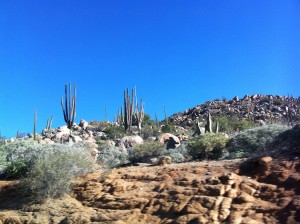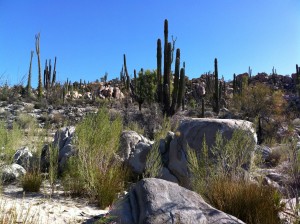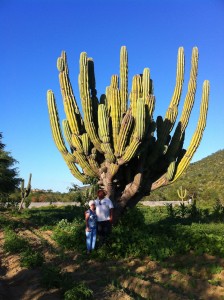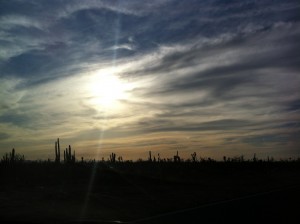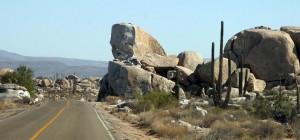Back in November, our little convoy of two vehicles (Ron in the lead and Mom and I following behind) left Ensenada in the cool of morning. The air conditioning was working in the Lincoln now, so Mom and I knew we would be comfortable as the day progressed and the heat of the desert intensified.
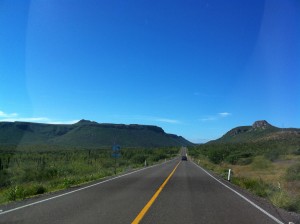
Driving the Baja can be extremely treacherous as shoulders don’t exist and the road is extremely narrow. Highway 1 is the only highway that connects the US to the southern tip of the Baja, so there is a lot of tractor/trailer traffic combined with passenger vehicles. Defensive driving is absolutely required as you take the winding roads and twist and climb through the mountains. We travel using walkie talkies, and there have been many situations when Ron has told me it is clear to pass when any sane person wouldn’t even consider it! Mom was a great sport and never showed any nervousness or concern – bless her for her faith and confidence in both of us. The many white crosses and memorials along the way are vivid reminders of the inherent danger this highway presents its travellers.
The beauty of this desert landscape is awe-inspiring. The variety of cacti and scenery will surprise anyone visiting this apparent “last frontier” for the first time and I am amazed and thrilled every time we have the opportunity to see it. There are so few people to have actually driven the Baja, and my precious Mom is now among them. It is an incredible experience and I’m so grateful to have had the opportunity to share it with her.
One of the contests that Ron and I play when we drive the Baja is “Who Can Spot The First Boojum”. This is what CaboBob.com says about the boojum (otherwise known as cirio):
“The boojum looks like nothing else. It is often described as a giant carrot growing upside-down, with its root sticking up to fifty feet in the air. It has a trunk and leaves, but o branches until it’s at least a hundred years old, when the trunk divides into two of more whip-like tops. A fifty year-old specimen might be a foot thick at its base, and less than five feet tall. It’s one of the slowest growing plants in the world, at a rate of a foot every ten years, which means a mature fifty-footer may be more than 500 years old.
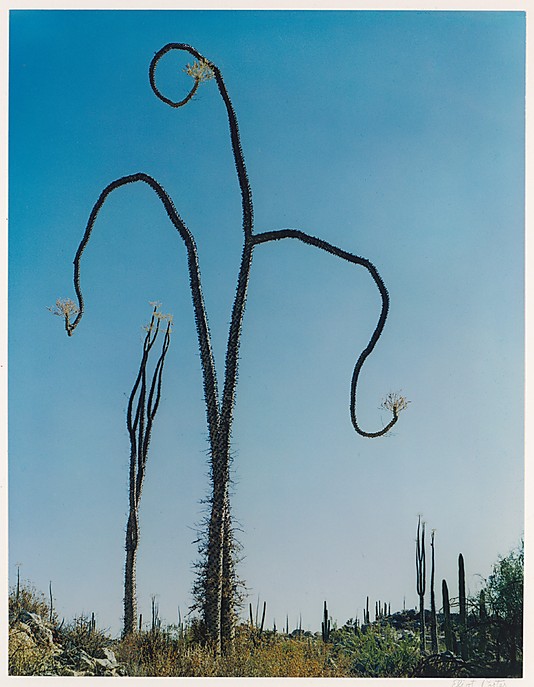
This photograph by Eliot Porter, entitled Cirio Near Las Tres Virgenes Volcano, Baja California (1966) is from the archives of the Metropolitan Museum of Art.
After plentiful rainfall, the boojum “candle” sprouts a flame of yellow blossoms at its tip, and its trunk is covered with small green leaves. When water is absent, it sheds all its leaves to preserve moisture within the trunk. The boojum is abundant in this two hundred mile strip of desert, but the only other place it grows is a small patch at the same latitude across the Sea of Cortez, in the State of Sonora.”
Ron sees people and families when he looks at boojums and I see dancers. They are rare and special and no two specimens look alike. Mom enjoyed them immensely as well as the elephant trees, the cardón (the largest cactus in the world that can grow to over sixty feet tall – often mistaken for its northern cousin, the saguaro), and the hundreds (literally hundreds!) of other cactus varieties found throughout the Baja.
We’d had a long day driving and it was starting to threaten sunset. We’d planned on getting to Cataviña by nightfall as the last thing you want to do is drive the Baja at night. We caught a glimpse in the twilight of the Boulder Field of Cataviña, sorry that we’d missed them in the last light of afternoon but excited to know that we would instead see it in the early morning light the next day.
There is a charming hotel, the Desert Inn, just off the highway that we’d planned on checking into. It is an identical twin to a hotel in San Ignacio to the south and both form part of a group of six hotels from Ensenada to Loreto that were formerly called La Pinta. We should have called ahead – the Desert Inn was fully booked as the Baja 1000 was well underway. Lots of racers, chase and support teams and had taken up all of the rooms. We quickly got back into our cars and raced back up the road to secure a room in the only other motel in this little town called Cabañas Linda (not the kind of place that you want as a namesake, believe me!).
The word “linda” in Spanish means beautiful and, believe me, this motel was FAR from that description! Other than driving on to Guerrero Negro, we really had no other choice unless we wanted to sleep in our cars. Since that wasn’t an option, we secured the last two rooms available.
The rooms were princess pink – from floor to ceiling – PINK! We were laughing with some racers that were staying in a room next to our two rooms – a double bed and bunk beds that were top to bottom princess pink. Hilarious! Doors that wouldn’t lock, furniture that was picked up, we’re sure, at roadside flea markets, bedding that you definitely wanted to keep your clothes on to lay upon, and bathrooms fixtures that you stood well away from!
Mom was a great sport about it all – in fact, far better than her daughter. It was her first truly authentic Mexican experience outside of the tourist destinations that my parents traveled to over the years. She said it reminded her of a story that my Dad told of staying somewhere once where he listened to the sound of beetles falling from the ceiling all night. Sometimes you’re tired enough that you can sleep anywhere – literally!
At eleven o’clock, the motel turned out the generator that ran the lights and power and I worried that Mom would have trouble finding the bathroom when she got up in the night. I thought knocking on her door to tell her what happened would scare her even more, so trusted that she would be careful and find her way safely. Lesson learned: always have a small flashlight in your travel bag!
The motel knew what they were doing as no one would stay there past day break and they had ample time to turn the rooms over. They had a café on site that only served instant coffee, so everyone staying at the motel headed south to the Desert Inn for our cup of java instead. We drove a short distance north again to take in the Boulder Field in the morning light. Boulders as big as large buildings and cacti growing out of nothing but rock – absolutely amazing!

